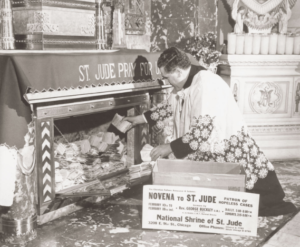The Claretians and St. Jude: A Feature

The National Shrine of Saint Jude was established on its present site by a Claretian missionary, the late Father James Tort, CMF, pastor of Our Lady of Guadalupe Church in Chicago. Many of Fr. Tort’s parishioners were laborers in the nearby steel mills, which were drastically cutting back their work forces early in 1929. The reduction of jobs was an ominous signal of the economic depression that would culminate with the stock-market crash the following October.
The Claretian pastor saw breadlines form in the community. He saw children undernourished, and his heart went out to his neighbors—Catholic and non-Catholic alike. Fr. Tort prayed for and with his people. He had started construction of a church; but having few financial resources, he felt the building project would have to be abandoned.
Fr. Tort was devoted to St. Jude Thaddeus, who was relatively unknown to the general Catholic population at that time. During the Middle Ages, St. Jude was widely venerated, but perhaps because of the confusion between his name and that of Judas Iscariot, he slipped into obscurity.
Night after night, however, Fr. Tort persevered in his prayers to St. Jude, asking his intercession and promising to erect a shrine in the saint’s honor if the church could be finished. In an effort to lift the spirits of his parishioners, Fr. Tort began regular devotions to St. Jude. On February 17, 1929, Auxiliary Bishop Bernard J. Sheil visited South Chicago to dedicate the statue of St. Jude. Thus began the first devotional services to St. Jude at Our Lady of Guadalupe; before the year ended, the country’s only National Shrine of St. Jude would be firmly established.

During the Lenten season of 1929, Fr. Tort noticed many of his parishioners praying before the statue of St. Jude. When all of the statues in the church were covered with purple cloth during Holy Week, he quietly moved the statue of St. Jude to a place of prominence on the right side of the church.
The congregation at Our Lady of Guadalupe Church showed such great response to the devotion to St. Jude that an overflow crowd attended services on the final night of the first Solemn Novena. This ended on the saint’s feast day, Oct. 28, 1929—the day before the US stock market crashed. More than 1,000 people stood outside the church to hear the service.
Eventually some donations came into the church—never enough to guarantee security, but enough to continue the spiritual and humanitarian endeavors of the parish and to enable the completion of the church. A modest shrine to St. Jude was finally established.
Word of the devotions to St. Jude gradually spread from that tiny corner of Chicago to other parts of the country. During the Great Depression and World War II, thousands of men, women, and children attended novenas at the Shrine; devotion to the “patron saint of hopeless causes” spread throughout the country.

Because the majority of St. Jude devotees cannot personally attend novena services in Chicago, the St. Jude League distributes novena literature throughout the country so devotees can participate in the novena wherever they live. They also send in their petitions for remembrance in the services.
The almost constant flow of letters into the National Shrine provide inspiring testimony of the desire of the faithful to ask for strength from God through prayers to Saint Jude.
The late Father Joachim DePrada, CMF, one of the successors to Fr. Tort as director of the National Shrine, once commented: “The continued interest in St. Jude indicates the hand of Providence at work. The change that St. Jude has wrought in the spiritual lives of many thousands of persons substantiates this belief.”

Today, the National Shrine provides solace and peace to hundreds of thousands of people through the St. Jude League.
The National Shrine of St. Jude welcomes visitors from all over the world. Devotion to St. Jude is grounded in love for a merciful God, and nourished by the power of prayer to one of Jesus’ Apostles. The Claretians share a profound gratitude for all members of the St. Jude League community and remember you in Masses and prayers.

